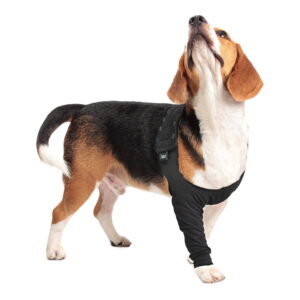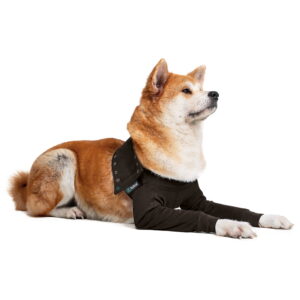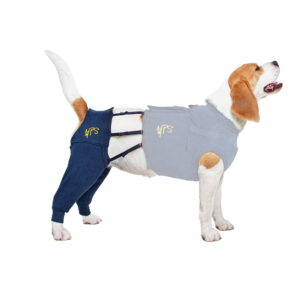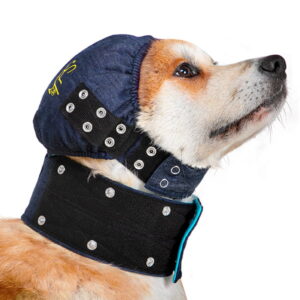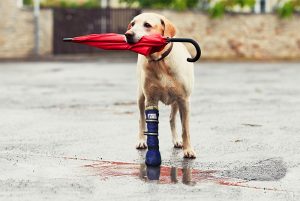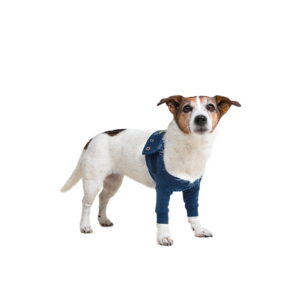Protective Clothing for Pet IV or Catheter Sites: Guide and Product Picks
Note: This guide covers IV (vein) catheters, not urinary catheters.
Pets come home with IV lines or catheter access ports for a host of reasons — fluids, medications, chemo, or blood draws. Keeping that site clean, covered, and out of paws’ reach is one of the simplest ways to prevent complications. Below, we explain how protective clothing works as a kind, comfy cone alternative, how to pick the right sleeve or suit, and how to care for the site day to day.
Quick product picks to get you started
- Dog front leg: Breathable front-leg IV sleeve with adjustable straps. Great as a cone alternative for a dog with an IV line.
Shop: Suitical Recovery Sleeve (Dog) or MPS Front-Leg Sleeve
- Back leg (dog or cat): Hind-leg sleeve or a full recovery suit that covers the thigh while keeping toileting easy.
Shop: Recovery Suit with hind-leg access
- Jugular/neck access (especially cats): Soft, high-neck recovery shirt with a small access flap; avoid compression over the line.
Shop: Neck-friendly Recovery Shirt
If your vet advises an Elizabethan collar, these garments can complement a cone or, in many cases, replace it. Always follow your vet’s instructions.
—
What is an IV/catheter site in pets?
An intravenous (IV) catheter lets your vet deliver fluids, medicines, or nutrition straight into a vein. Common locations are the front leg (cephalic vein), back leg (saphenous), or the neck (jugular). The external hub or line needs to stay clean, secure, and easy for your vet to access — and that’s where protective clothing helps.
Risks to watch without protection:
- Infection if saliva, dirt, or litter get near the site
- Dislodgement from licking, chewing, scratching, or snagging
- Inflammation or swelling from friction and movement
Why use protective clothing? Cone alternatives explained
Protective sleeves and recovery shirts create a soft barrier that:
- Blocks licking and chewing without the stress of a hard cone
- Keeps bandages clean and helps prevent snagging on furniture or bedding
- Lets vets access the site quickly via flaps or openings
- Can calm anxious pets thanks to gentle, even pressure from well-fitted garments
Many families find a sleeve or suit is a kinder cone alternative for IV site protection. For determined lickers or chewers, combine a sleeve/suit with a cone per your vet’s advice.
—
Which product do I need? A 2-minute chooser
Step 1 — Pet: Dog or Cat Step 2 — Catheter location: Front leg, Back leg, or Jugular/neck Step 3 — Behaviour & sensitivity: Calm, Licker/Chewer, Anxious/Sensitive skin, Hot weather
Recommended picks
- Front leg (dog)
– Calm: Breathable front-leg IV sleeve; secure but gentle fit – Licker/Chewer: Front-leg sleeve plus recovery suit for extra coverage; add cone if advised – Hot weather: Lightweight, moisture-wicking fabric
- Front leg (cat)
– Calm: Soft, low-bulk sleeve with quiet fasteners – Anxious: Lightweight recovery suit with leg coverage; minimal closures to reduce noise
- Back leg (dog or cat)
– Hind-leg sleeve or a recovery suit that leaves toileting clear – Choose stretch fabric with anti-slip straps to keep the sleeve in place
- Jugular/neck (often cats)
– High-neck recovery shirt with a small access flap – Avoid tight bands; nothing should compress the jugular vein – Consider pairing with a soft cone if your cat is very persistent
Tip: Sighthounds and deep-chested breeds may need special sizing for a good shoulder fit. Kittens and toy breeds often do best with adjustable closures.
—
Sleeve vs suit vs disposable covers: what’s best?
- Front-leg IV sleeve
– Best for: Localised protection of a front-leg IV site – Pros: Low bulk, quick to fit, great cone alternative – Consider: May need a suit or cone for determined chewers
- Full-body recovery suit
– Best for: Back-leg or jugular access; anxious pets who relax with gentle coverage – Pros: Broad coverage, access flaps, keeps bandages cleaner – Consider: Choose breathable fabric for warm weather
- Disposable covers
– Best for: Short-term use or when washing is difficult – Pros: Hygienic single-use convenience – Consider: Ongoing cost; ensure breathability
—
How to measure and choose the right size
A good fit keeps the site protected without restricting movement or blood flow.
Measure with a soft tape:
- Chest girth: Around the widest part of the chest
- Neck circumference: Especially important for jugular access
- Leg circumference: Just above the wrist (front) or hock/ankle (back)
- Leg length: Elbow to wrist (front) or stifle to hock (back)
- Weight and breed: Cross-check against the brand’s size chart
Fit check:
- You should be able to slide two fingers under the fabric
- No slipping, twisting, or rubbing at the elbow or armpit
- For jugular access: Neck should be snug but never tight; no visible pressure on the vein
Need help? See our size finder and measuring guide.
—
Daily home care: a simple AM/PM checklist
Morning
- Check the site through the access flap for swelling, heat, redness, or discharge
- Ensure the sleeve or suit has not shifted; re-adjust straps if needed
- Confirm the bandage is clean and dry
- Offer a calm sniff-and-stretch break; reward relaxed behaviour
Evening
- Repeat the site check; compare to the morning
- Wipe any fur around the area with vet-approved wipes if advised
- Wash reusable garments if soiled; use mild, fragrance-free detergent and air-dry
- Log any changes (photos help) to share with your vet
Red flags — call your vet promptly
- Swelling, warmth, redness, or pain around the site
- Pus, odour, or persistent dampness under the garment
- Your pet fixates on the spot, cries, or won’t bear weight
- Any movement or loosening of the catheter or bandage
- Fever, lethargy, vomiting, or behaviour change
—
Dogs vs cats: small but important differences
Dogs
- Often tolerate sleeves well; choose breathable, durable fabrics
- Select designs that allow easy toileting without removal
- For active dogs, consider anti-slip straps or a suit to stabilise a sleeve
Cats
- Prefer lightweight, low-noise closures; less bulk around shoulders
- Check more often for fur matting and skin sensitivity
- Jugular catheters are more common in cats — prioritise soft, non-compressive neck coverage
—
Best practices for safe use
- Follow your vet’s plan: They’ll advise what to cover, how long, and when to remove for checks
- Keep it clean: Wash reusable garments daily or when soiled; replace disposable covers as directed
- Check fit: Garments should stay put without digging in; re-fit after naps and walks
- Reduce stress: Pair short wear sessions with treats, praise, and calm handling
- Never block vet access: Use garments with flaps or openings so checks are easy
—
FAQs
Will this replace an Elizabethan collar?
- Often, yes. A well-fitted IV sleeve or recovery suit can be a kinder cone alternative. If your pet is determined to lick or chew, your vet may still suggest using a cone as well.
Can my pet toilet normally in these garments?
- Quality sleeves and suits are designed so dogs and cats can toilet without removal. Check the product description and size for your pet’s anatomy.
How often should I wash or replace the garment?
- Daily washing is ideal if worn continuously. Have a spare so one can dry while the other is worn. Replace any garment that becomes stretched, frayed, or soiled you cannot clean thoroughly.
What if the site swells or looks red?
- Stop your pet from interfering, keep the garment clean and dry, and call your vet. Do not remove the catheter or bandage unless your vet instructs you to.
Is this suitable for jugular catheters?
- Yes, choose a soft recovery shirt with a high but gentle neck and a small access flap. Avoid anything that compresses the vein. Follow your vet’s guidance closely.
Can a cat wear clothes after an IV catheter?
- Many can, especially with soft, lightweight garments. Introduce gradually and keep sessions positive.
How do I stop my dog from pulling out the IV line?
- Use a snug, breathable sleeve or a recovery suit to cover the area, keep boredom low with enrichment, and consider a cone if your vet recommends it.
—
Trusted guidance
- Aligned with veterinary best-practice recommendations for catheter care and hygiene (AAHA, WSAVA, RCVS)
- This article is for general guidance only and does not replace your veterinarian’s advice
—

